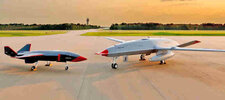Mofra
Moderator
- Dec 6, 2005
- 73,317
- 215,713
- AFL Club
- Western Bulldogs
- Other Teams
- Footscray, Coney Island Warriors
- Moderator
- #126
The nuke subs may very well act as underwater AWACs in time - there is already significant interoperability between the latest block F-35 systems and larger drones. That seems to be the model the US is working towards at sea as well.Yes, a lot of that ISR work by subs will be replaced by UUV's. Without folks on board they will be able to sit still for very long periods of time. Should free up manned subs for other missions.


























